As an Amazon Associate KitchenwareSets.com earns from qualifying purchases.
Dining Room Table Makeover DIY Ideas That Look High End On A Budget
Are you tired of looking at that dated, worn-out dining table in the heart of your home? Does the thought of dropping a small fortune on a new one make your wallet ache? You’re not alone. That 90s oak or scratched-up hand-me-down can drag down the entire feel of your living space, making it feel old and uninspired.
So many of us dream of a beautiful, stylish dining area but feel stuck with what we have due to a tight budget. It’s frustrating when the centerpiece of your family gatherings doesn’t reflect your personal style. You want a change, but the options seem limited to either an expensive replacement or living with the eyesore. But what if there was another way?
The good news is that revitalizing a dated dining table is a cost-effective way to transform your dining space. We’ve transformed dozens of thrifted and marketplace finds, and we’re sharing the exact methods that deliver a flawless, durable finish every time. With a few key supplies like furniture paint, sandpaper, and a durable topcoat, you can achieve a high-end, modern look for well under $150, making it a perfect weekend DIY project.
Tired of Your Dated Dining Table But Don’t Have the Budget for a New One?
That worn, outdated dining table sitting in your home holds incredible potential. It’s not just a piece of old furniture; it’s a blank canvas waiting for a stunning transformation. A dining room table makeover is one of the most impactful DIY projects you can tackle, instantly revitalizing your entire space without the hefty price tag of buying new. Whether you’re dealing with 90s orange oak, a scratched laminate top, or just a style you’ve outgrown, a little creativity and effort can produce a high-end look you’ll be proud to gather around.
We’ve transformed dozens of thrifted and marketplace finds, and we’re sharing the exact methods that deliver a flawless, durable finish every time. This guide will walk you through the essential steps and inspire you with stunning, budget-friendly ideas to turn your old table into the centerpiece your home deserves.
The Essential 4-Step Process to a Flawless Dining Table Refinish
The secret to a professional-looking finish isn’t expensive tools; it’s a methodical process. To refinish a dining table, you must: 1. Prep & Clean, 2. Sand & Repair, 3. Paint or Stain, and 4. Seal with a topcoat. Following these four stages in order ensures your hard work results in a beautiful, durable finish that lasts for years. Rushing or skipping a step, especially the prep work, is the number one reason DIY projects fail. Let’s break down each critical stage.
Step 1: The Critical Prep and Cleaning Phase
The most crucial step for a lasting finish is thoroughly cleaning and degreasing the surface before you do anything else. This removes years of built-up oils, dirt, and old furniture wax that would otherwise prevent your new paint or stain from adhering properly, leading to peeling and chipping down the line.
Materials Needed:
* Rubbing alcohol
* Clean rags
* TSP (trisodium phosphate) or a degreasing alternative
* Bucket
* Gloves
Step-by-Step Directions:
1. If you suspect an old wax finish (common on vintage pieces), apply rubbing alcohol to a clean rag and wipe down the entire table. This will dissolve and lift the stubborn wax buildup.
2. Mix your TSP solution in a bucket according to the manufacturer’s directions. Always wear gloves when handling TSP.
3. Using a rag soaked in the TSP solution, scrub every surface of the table. This powerful degreaser will cut through all the grime, oils from hands, and cleaning product residue.
4. Thoroughly rinse the table by wiping it down with a separate rag dampened with clean water. This step is vital. Allow the table to dry completely.
Pro-Tip: Don’t skip the final rinse with clean water. Any leftover TSP film will act as a barrier and cause your new paint to peel right off.
Step 2: Sanding and Repairs for a Silky Smooth Foundation
The goal of sanding for a painted finish is to scuff up and dull the existing topcoat, creating a texture for the new paint to grip onto. You do not need to sand the entire piece down to bare wood, which saves an immense amount of time and effort. This is also the perfect time to address any structural issues.
Materials Needed:
* 220-grit sandpaper or sanding block
* Optional: orbital sander
* Tack cloth or clean, damp rag
* Screwdriver or wrench
Step-by-Step Directions:
1. Using 220-grit fine sandpaper, lightly sand all surfaces of the table, including the legs and apron. Your goal is to simply remove the shine from the old finish. An orbital sander can speed this process up significantly on the tabletop.
2. Always move your sander in the direction of the wood grain to avoid creating cross-grain scratches.
3. Once every surface feels dull to the touch, wipe away all the sanding dust with a tack cloth or a clean, damp rag. A dust-free surface is essential for a smooth paint job.
4. Inspect the table for any loose legs or wobbly parts. Tighten any loose screws or bolts with a screwdriver or wrench to ensure the table is sturdy.
Lesson Learned: Many people think they need to sand down to bare wood. For painting, a simple ‘scuff sand’ is all you need for great adhesion and saves you hours of work and a huge mess.
Step 3: The Transformation – Applying Paint or Stain
Applying your paint or stain correctly is key to achieving a smooth, professional finish without brush marks. The secret is using multiple thin, even coats rather than one thick, globby one. This technique provides better coverage and a much more durable result.
Materials Needed:
* High-quality furniture paint (mineral chalk paint is a great option) or wood stain
* Quality synthetic paintbrush
* Small water misting bottle
* Painter’s tape (for two-tone looks)
Step-by-Step Directions:
1. For Painting: Lightly mist your synthetic brush with water. This helps the paint flow smoothly from the bristles. Apply a thin, even coat of paint, starting your strokes in the middle of a section and working outwards toward the edges.
2. Overlap your strokes slightly while the paint is still wet. This technique, called “maintaining a wet edge,” is the best way to minimize brush marks.
3. Allow the first coat to dry completely. Once dry, give it a very light sanding with 220-grit paper, wipe the dust, and then apply your second coat for full coverage.
4. For Staining: Apply your stain using a clean, lint-free rag or a foam brush. Let it penetrate for a few minutes, then wipe away any excess with another clean rag. You can apply multiple coats to achieve a deeper, richer color.
Pro-Tip: When painting a large flat surface like a tabletop, avoid starting your brush stroke at the edge. Starting in the middle and feathering out prevents thick paint buildup on the ends and corners.
Step 4: Sealing the Deal with a Durable Topcoat
The final, non-negotiable step is protecting your beautiful new finish with at least 2-3 thin coats of a durable, water-based polyurethane topcoat. A dining table sees heavy daily use, from hot plates and spills to sliding dishes. A quality sealer is the armor that will protect your hard work from scratches, water rings, and chipping.
Materials Needed:
* Water-based polyurethane or clear topcoat in your desired sheen (e.g., flat, matte, satin)
* Foam brush
* Angled brush
* 400-grit sandpaper (optional, for an ultra-smooth finish)
Step-by-Step Directions:
1. Using a foam brush for the flat tabletop and an angled brush for legs and contours, apply a very thin, even layer of your topcoat.
2. Work quickly and use long, straight strokes from end to end. Avoid going back over areas that have already started to dry, as this will create streaks.
3. Let the first coat dry completely according to the manufacturer’s instructions (usually a few hours).
4. For the smoothest possible finish, lightly sand between coats with super-fine 400-grit sandpaper, making sure to wipe away all dust before the next coat.
5. Apply a total of 2-3 coats for maximum durability, allowing proper dry time between each.
Pro-Tip for Dark Colors: To prevent a hazy or cloudy look on dark paint colors like black or navy, mix a tiny drop (less than 1%) of your paint color directly into the topcoat before applying. This tints the sealer just enough to eliminate any potential cloudiness.
7 Stunning Dining Table Makeover Ideas for 2025 (That Look Expensive)
Ready for some inspiration? A dining room table makeover can go far beyond a simple coat of paint. We’ve curated these ideas from top interior design trends and successful DIY projects, focusing on transformations that provide the most visual impact for the effort.
Here are 7 high-end dining table makeover ideas you can achieve on a budget:
1. The Classic Two-Tone Farmhouse
2. The Modern Faux Marble Top
3. The Rustic Reclaimed Wood Top
4. The Chic Distressed Chalk Paint Finish
5. The Sleek Industrial Metal Base Swap
6. The Artistic Stenciled Pattern Top
7. The High-Gloss Epoxy Resin River Table
1. The Classic Two-Tone Farmhouse (Stained Top, Painted Base)
To achieve the timeless two-tone look, combine a beautifully stained wood top with a painted base in a contrasting color like white or black. This classic farmhouse style adds instant character and warmth to any dining space.
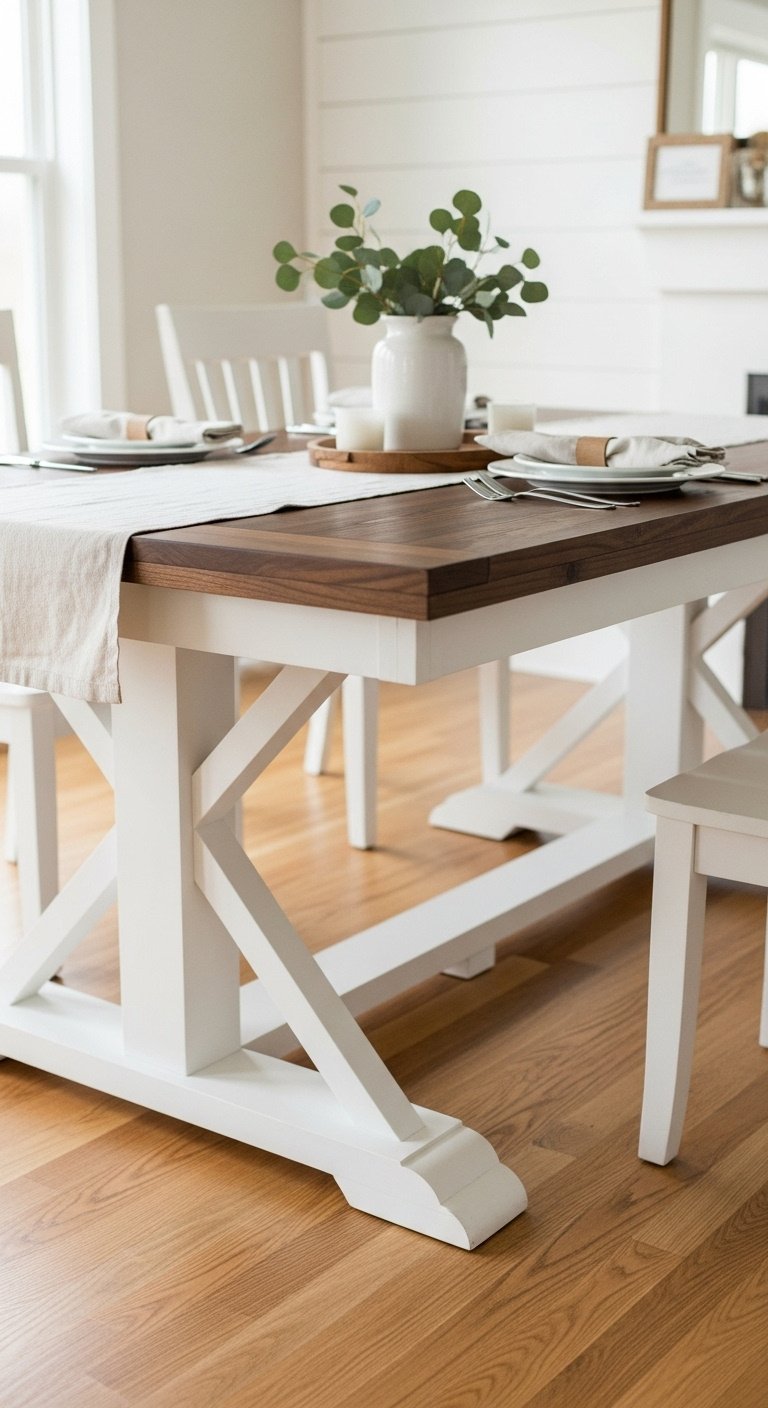
Materials Needed:
* Painter’s tape
* Wood stain
* Furniture paint (e.g., white or black chalk paint)
* Sandpaper, brushes, topcoat
Step-by-Step Directions:
1. Follow the essential prep and sanding steps (1 & 2 from the section above) for the entire table.
2. Using high-quality painter’s tape, carefully tape off the tabletop from the apron and legs to create a crisp line.
3. Paint the base and legs with 2-3 coats of your chosen furniture paint.
4. While the base is drying, apply your desired wood stain to the tabletop, following the product instructions and wiping away any excess.
5. Once both the painted and stained sections are fully dry, carefully remove the tape. Apply 2-3 coats of a durable polyurethane topcoat to the entire table for seamless protection.
Pro-Tip: Use a gel stain for the top if you’re working with a tricky wood species like pine or dealing with a surface you couldn’t sand perfectly. Gel stains are thicker and more forgiving, sitting on top of the wood to give you a more even color.
Pin this classic look to your ‘Farmhouse Dream’ board!
2. The Modern Faux Marble Top with Contact Paper
For a quick, affordable, and non-permanent modern update, use high-quality, marble-effect contact paper to cover the tabletop. This is a brilliant solution for renters or for updating laminate tables where sanding and staining isn’t an option.
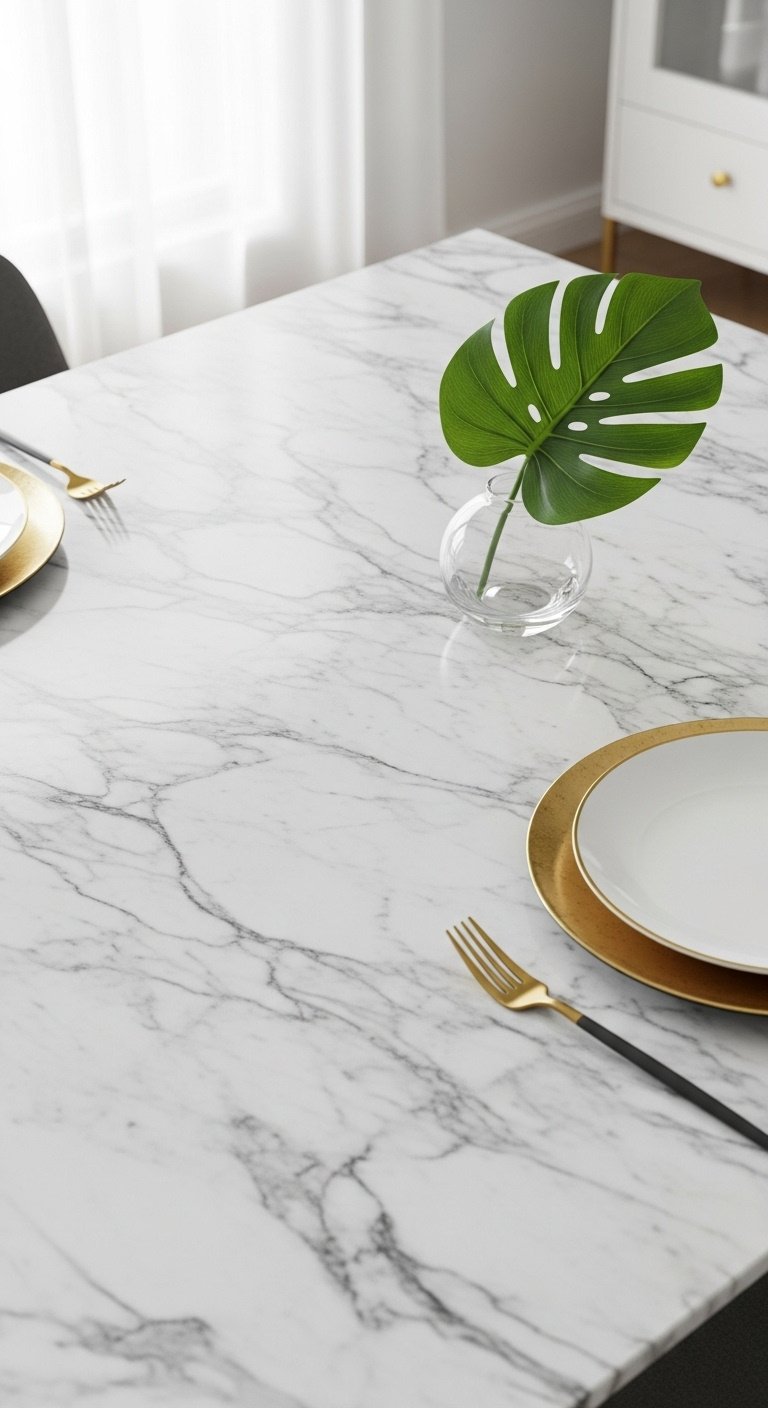
Materials Needed:
* High-quality marble-effect contact paper
* Measuring tape, scissors, craft knife
* Squeegee or credit card
Step-by-Step Directions:
1. Thoroughly clean and dry the tabletop. The surface must be completely smooth and free of debris for the best adhesion.
2. Measure your tabletop and carefully cut the contact paper, leaving a few inches of overhang on all sides.
3. Peel back just a small section of the backing paper and align it perfectly with one edge of the table.
4. Slowly and patiently peel the backing away while using a squeegee to smooth the paper onto the surface. Work from the center outwards to push out any air bubbles as you go.
5. Wrap the overhanging edges tightly around the sides and underneath the tabletop. Use a sharp craft knife to trim the excess for a clean, seamless finish.
Lesson Learned: Don’t try to apply the whole sheet at once; you’ll end up with a mess of bubbles and creases. Work in small, manageable sections, smoothing as you go. A hairdryer on a low heat setting can help make the vinyl more pliable and easier to stretch around curved edges or corners.
Save this budget-friendly tips to your ‘Apartment Decor’ board!
3. The Rustic Reclaimed Wood Top Replacement
To add authentic rustic character, replace the existing tabletop entirely with a new top built from reclaimed wood planks. This method dramatically changes the table’s style and is perfect for covering a damaged or dated laminate top that can’t be refinished.
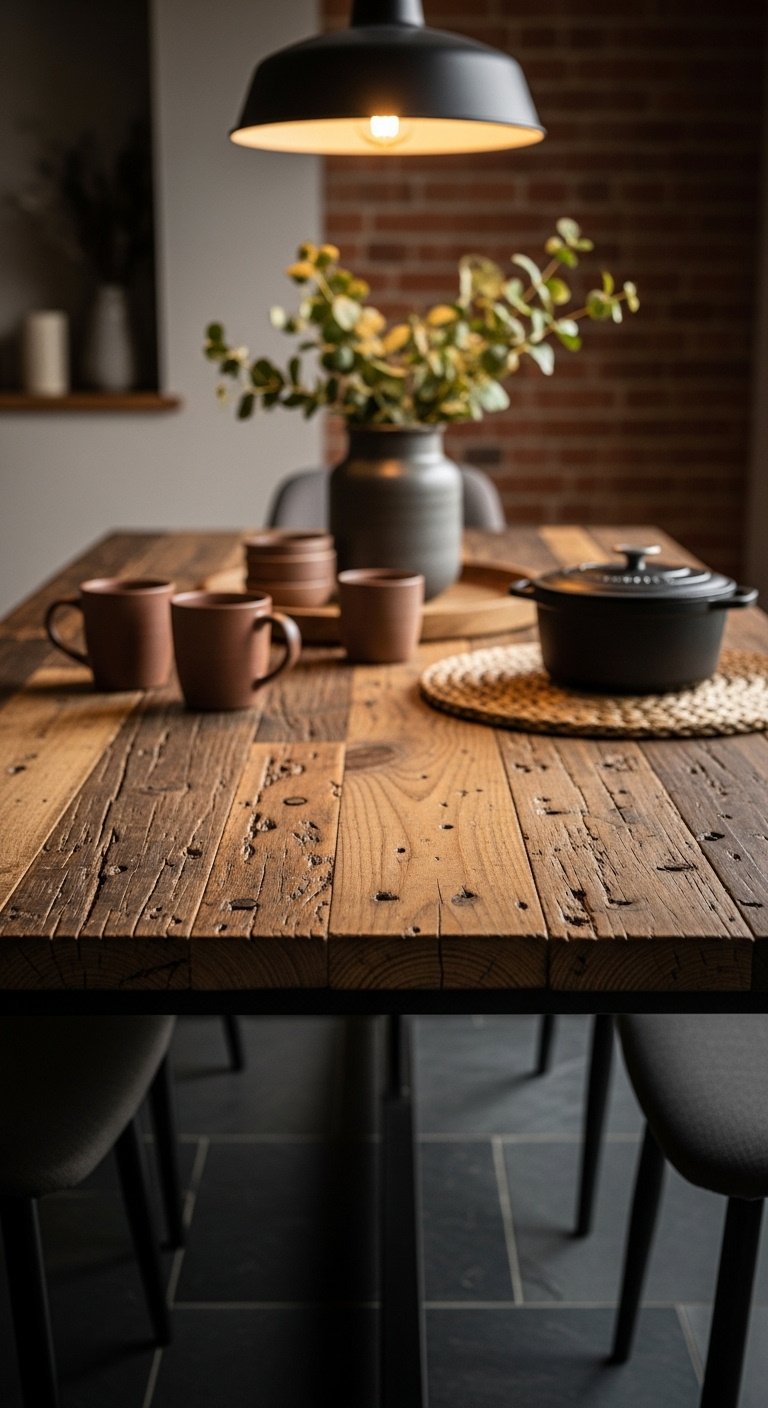
Materials Needed:
* Reclaimed wood planks
* Wood glue and clamps
* Saw, sander, wood screws
* Polyurethane
Step-by-Step Directions:
1. Carefully remove the old tabletop from the table base, usually by unscrewing it from underneath. Measure the dimensions of the old top.
2. Cut your reclaimed wood planks to the desired length for the new top.
3. Arrange the planks in an order you like. Join them together by applying a generous amount of wood glue along the edges. Use bar clamps to hold them tightly together while the glue dries completely.
4. Once the glue is cured, sand the new tabletop smooth, preserving as much of the rustic character (like saw marks or nail holes) as you like.
5. Securely attach the new top to the existing table base using wood screws from underneath.
6. Seal the entire new top with 2-3 coats of durable polyurethane to protect it.
Pro-Tip: When sourcing reclaimed wood, look for old shelving, barn wood, or even construction site offcuts. Ensure the wood is completely dry and pest-free before bringing it indoors for your project.
Love rustic decor? Pin this transformation for later!
4. The Chic Distressed Chalk Paint Finish
To create an aged, shabby chic look, use chalk-style paint and then strategically sand the edges and details to reveal the wood underneath. This technique adds a layer of vintage charm and is incredibly forgiving for beginner painters.
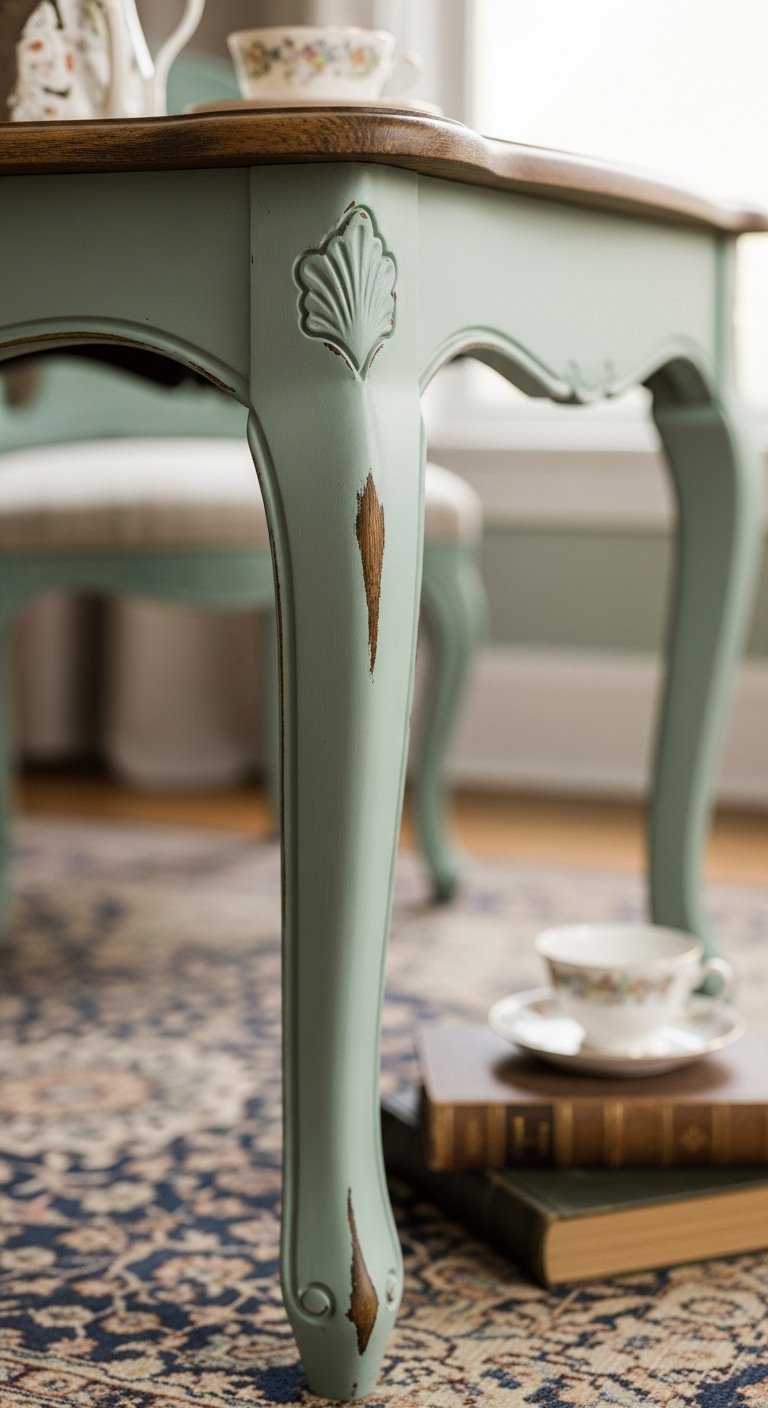
Materials Needed:
* Chalk-style paint
* Paintbrush
* Medium-grit sandpaper
* Clear or dark furniture wax
* Clean, lint-free rags
Step-by-Step Directions:
1. Clean the table thoroughly. One of the main benefits of chalk paint is that it often requires no sanding or priming before application.
2. Apply two coats of your chosen chalk paint color, allowing each to dry. Don’t worry about a perfectly smooth finish; a little bit of texture adds to the charm.
3. Once the second coat is fully dry, take your medium-grit sandpaper and lightly sand the edges, corners, and any raised details where wear would naturally occur over time.
4. Wipe away all the sanding dust with a clean rag.
5. To seal and protect the paint, apply a coat of clear furniture wax with a rag, working it into the paint in a circular motion. For a more aged look, work a small amount of dark wax into crevices and details before the clear wax fully cures.
Lesson Learned: It’s very easy to get carried away with distressing. Start light—you can always sand off more paint, but you can’t easily put it back on. Focus on high-contact areas for the most authentic look.
Get the perfect shabby chic look! Save this tutorial.
5. The Sleek Industrial Metal Base Swap
For an instant modern or industrial update, keep your existing wood tabletop but replace the dated wooden legs with a new, sleek metal base. This high-contrast look is incredibly popular and completely changes the personality of the table.
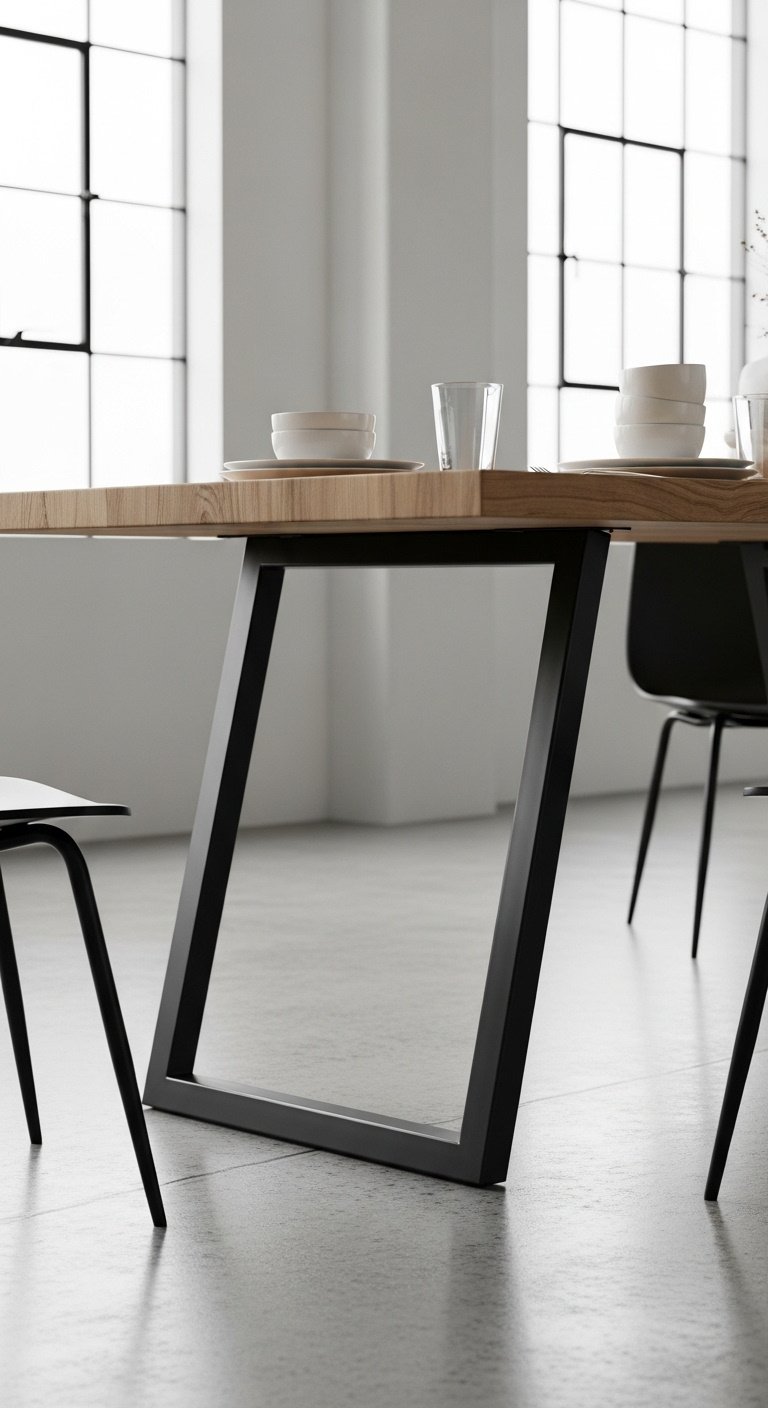
Materials Needed:
* Pre-made metal table legs/base
* Drill
* Wood screws
* Measuring tape
Step-by-Step Directions:
1. Refinish your existing tabletop using the staining or painting method of your choice from the steps above. Allow it to cure completely.
2. Carefully flip the finished tabletop upside down onto a soft surface like an old blanket to protect it.
3. Unscrew and remove the old wooden legs or pedestal base.
4. Position your new metal base in the center of the tabletop’s underside. Use a measuring tape to ensure it is perfectly centered and square.
5. Use a drill to attach the new base with the appropriate-length wood screws, making sure they are long enough for a secure hold but not so long they poke through the top.
6. With a helper, carefully flip the table upright.
Pro-Tip: Before you buy new legs, double-check the weight capacity of the metal base and the approximate weight of your tabletop. This is crucial to ensure they are a safe and stable match that won’t wobble.
Pin this modern makeover idea to your ‘Industrial Home’ board!
6. The Artistic Stenciled Pattern Top
To create a truly unique, custom piece, add an intricate pattern to a painted tabletop using a furniture stencil. This technique can achieve a wide range of styles, from bohemian and geometric to classic and floral, making your table a one-of-a-kind work of art.
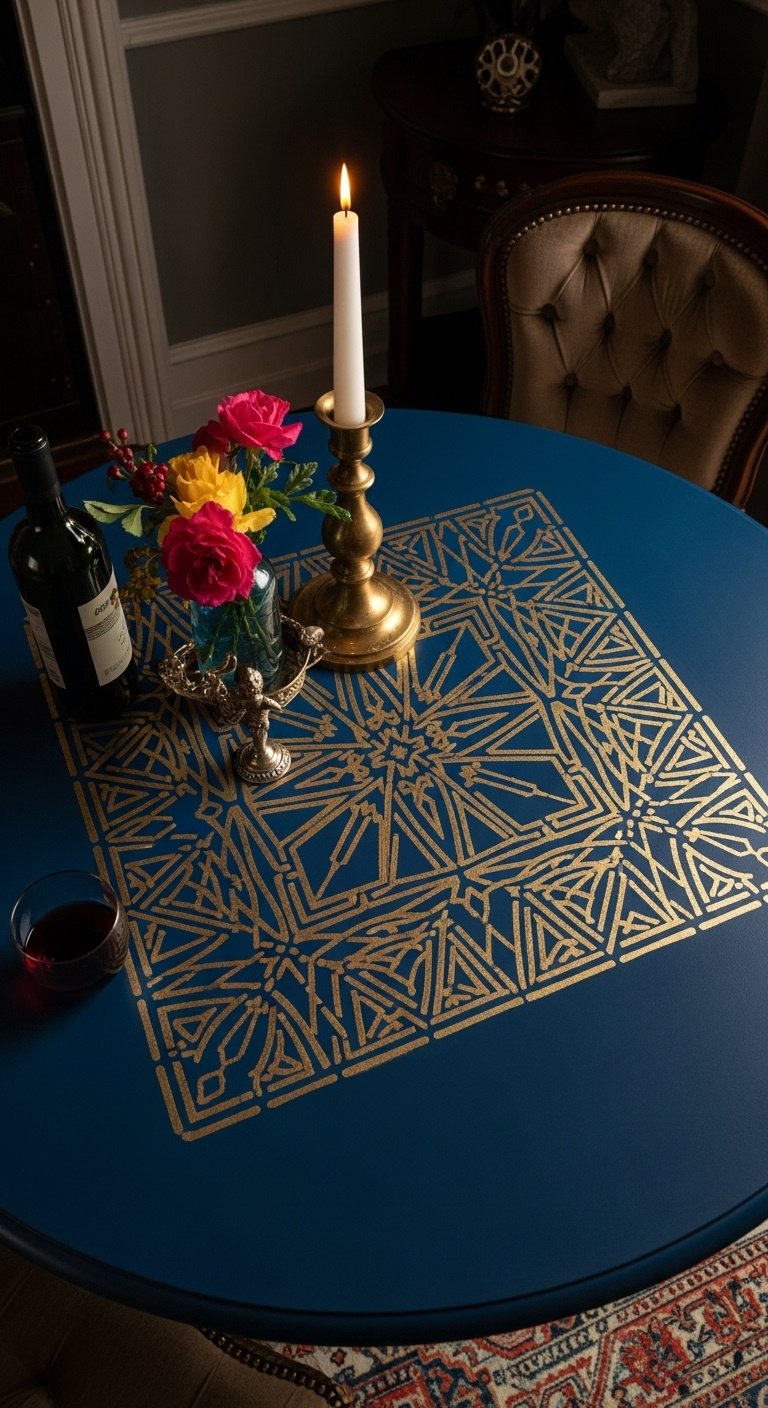
Materials Needed:
* Base coat of paint
* Furniture stencil
* Stencil brush or small foam roller
* Second paint color for the pattern
* Painter’s tape
* Polyurethane topcoat
Step-by-Step Directions:
1. Prep and paint your tabletop with 2 coats of your chosen base color. Let it dry and cure completely.
2. Position your stencil on the table and secure it firmly in place with painter’s tape so it cannot shift.
3. Dip your stencil brush or foam roller into your pattern color, then off-load most of the paint onto a paper towel. You want a “dry brush.”
4. Use an up-and-down dabbing motion (stippling) to apply the paint over the stencil. Do not use a brushing motion, as this will force paint under the stencil and ruin your crisp lines.
5. Carefully lift the stencil, reposition it to continue the pattern, and repeat the process until the surface is covered.
6. Let the stenciled pattern dry completely, then seal with 3 coats of a durable polyurethane topcoat to protect the design.
Lesson Learned: The biggest mistake people make with stenciling is using too much paint. Off-load almost all the paint from your brush onto a paper towel before dabbing it onto the stencil. A dry brush is the absolute key to getting sharp, crisp lines with no bleeding.
Add a touch of glam! Pin this stenciling tutorial.
7. The High-Gloss Epoxy Resin River Table
For a dramatic, high-end modern statement, create a “river” of colored epoxy resin that flows between two wood planks. While this is a more advanced project, the result is a stunning, glossy, and incredibly durable tabletop that is a true conversation starter.
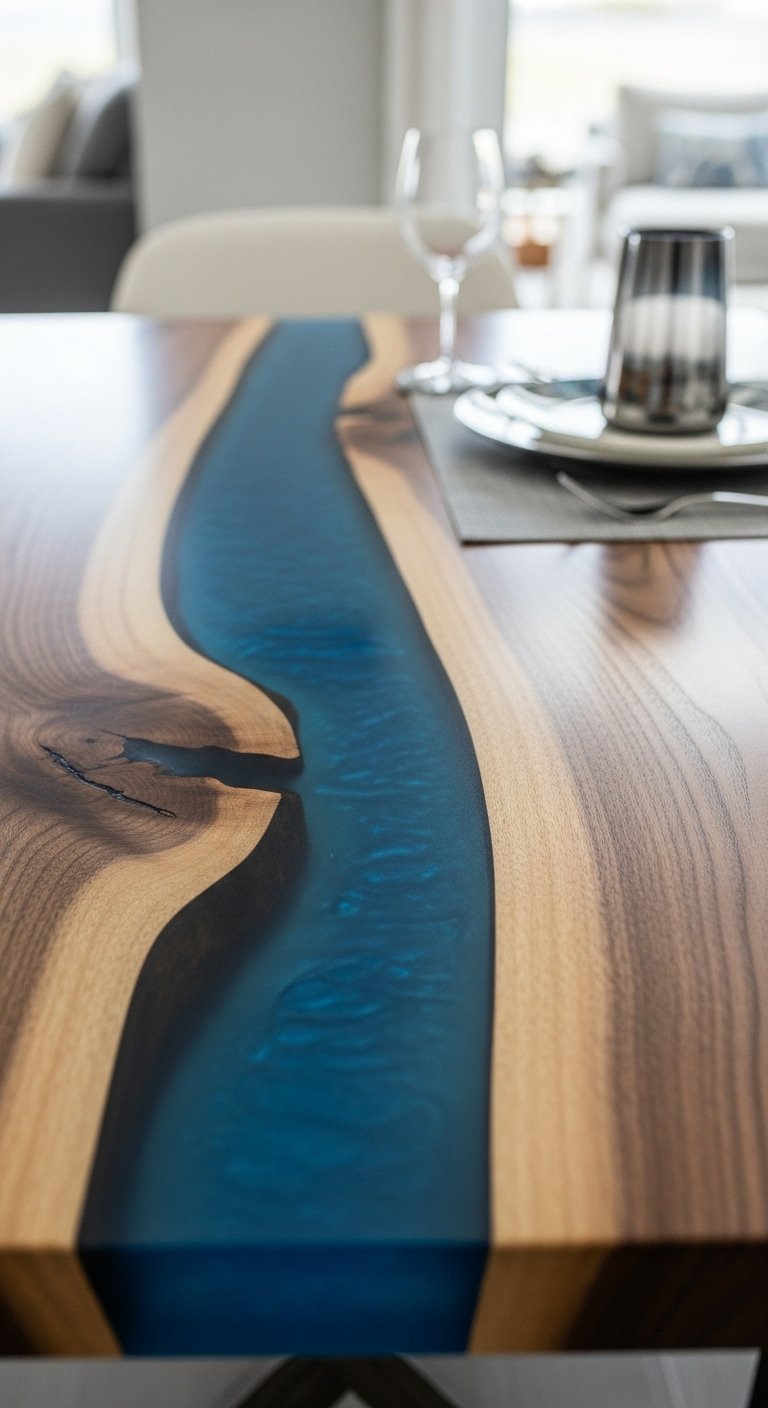
Materials Needed:
* Two wood planks (live edge preferred)
* Melamine board for a mold
* Silicone caulk
* Deep-pour epoxy resin and mixing buckets
* Pigments (optional)
* Propane torch or heat gun
Step-by-Step Directions:
1. Build a watertight box, or mold, out of melamine board that is slightly larger than your desired tabletop dimensions. Seal all the inside seams with silicone caulk and let it cure.
2. Place your wood planks inside the mold, leaving a gap between them for the “river.” Clamp them down securely so they don’t float.
3. Carefully mix the two parts of the epoxy resin according to the manufacturer’s specific directions. This is the most critical step. Stir in any color pigments you desire.
4. Slowly pour the mixed epoxy into the river gap.
5. Use a propane torch or heat gun, held several inches above the surface, to briefly wave heat over the epoxy. This will pop any air bubbles that rise to the top.
6. Let the epoxy cure for the recommended time, which can be several days. Once fully cured, you can demold the slab, then sand the entire piece smooth and apply a final topcoat.
Pro-Tip: This is an advanced project. Start with a very small test project, like making a coaster, to understand how epoxy behaves before tackling a large, expensive pour like a dining table. Precision and patience are key.
Ready for a challenge? Pin this ultimate DIY project!
Key Takeaways: Your Quick Guide to a Dining Room Table Makeover
Feeling ready to tackle your project? Keep these essential points in mind for a successful transformation.
- Prep is Paramount: Never skip cleaning with a degreaser like TSP and scuff sanding the old finish. This foundation prevents 90% of future problems like chipping and peeling.
- Choose the Right Materials: Use furniture-specific paint (like chalk or mineral paint) and a durable, water-based polyurethane topcoat. They are designed to withstand the heavy use a dining table gets.
- Technique Matters: Always apply multiple thin coats of both paint and sealer rather than one thick coat. This results in a smoother, more professional, and more durable finish.
- Get Creative: A makeover can be more than just paint. Consider a classic two-tone finish, a budget-friendly contact paper top, or even new industrial metal legs to completely change the style of your table on a budget.
People Also Ask About Dining Room Table Makeovers
How do you make an old dining table look modern?
To make an old table look modern, focus on clean lines and contrasting materials. Paint the base a neutral color like black, white, or charcoal gray. Consider replacing traditional wooden legs with sleek metal ones for a high-impact change. For the top, you can stain it a dark, rich color, cover it with a modern faux-marble contact paper, or for a truly contemporary look, pour a glossy epoxy resin top.
What is the average cost of refinishing a dining room table?
The average DIY cost to refinish a dining room table is typically between $75 and $150. This budget covers essential supplies like sandpaper, cleaner, high-quality furniture paint or stain, good brushes, and a durable topcoat. The final cost depends on the size of the table and the specific products you choose, but it is significantly cheaper than buying a new table.
What is the trend for dining room tables in 2025?
The biggest trends for dining room tables in 2025 focus on natural materials, unique shapes, and functionality. Warm, natural wood finishes are very popular, as are tables with interesting pedestal or trestle bases instead of simple legs. We’re also seeing a move towards expandable designs and organic, curved shapes over sharp rectangular tables, creating a softer, more inviting dining space.
Final Thoughts
Your dated dining table holds so much potential! It’s more than just a piece of furniture; it’s an opportunity to infuse your style into the heart of your home. With a little bit of effort and creativity, you can turn it into the stunning centerpiece your home deserves—a piece you can be proud of for years to come, all without breaking the bank.
Which makeover idea are you most excited to try first? Let us know in the comments below
